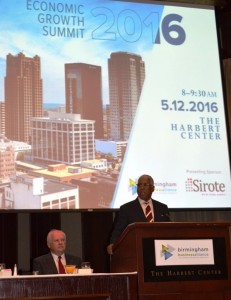
The nearly $1.1 billion in capital investment from the announced economic development projects in the Birmingham metro area last year may be an all-time high for the region.
Brian Hilson, CEO of the Birmingham Business Alliance (BBA), told business and community leaders at this morning’s 2016 Birmingham Regional Economic Growth Summit that the figure is at or near a record. The investment came from 90 announced projects that will create more than 3,500 jobs.
“The goal isn’t statistics, it’s creating economic opportunity,” Hilson said.
However, statistics for 2015 did show mostly encouraging signs for that economic opportunity. Consider:
• Manufacturing accounted for 64 percent of the projects, 49 percent of the jobs and 75 percent of the capital investment announced last year.
• Finance and insurance industries made up 8 percent of the projects, 29 percent of the jobs and 14 percent of capital investment.
• Life sciences and information technology, where the BBA sees potential for great growth, accounted for 12 percent of the projects, 8 percent of the jobs and 4 percent of the capital investment in 2015.
• Between 2001 and 2010, the metro area had an annual average of 55 new projects, 1,875 jobs and capital investment of $255.7 million. Between 2011 and 2015, the first years of Blueprint Birmingham, those annual averages were 76 projects (up 38 percent), 2,890 jobs (up 54 percent) and $569.3 million invested (up 123 percent).
Optimism in the air at BBA Economic Growth Summit from Alabama NewsCenter on Vimeo.
“Our economy remains strong and continues to grow,” said Ray Watts, president of UAB and chairman of the BBA board of directors. “But more than that, I believe the trends we are seeing in Birmingham and in the metro region are moving us in the right direction.”
Andy Levine, president of Development Counsellors International, delivered the keynote address. Levine’s company has been working with BBA to enhance Birmingham’s national image.
Levine said while some people associate the Jefferson County bankruptcy as a modern-day negative, there are positive perceptions centering on Birmingham’s culinary scene, downtown redevelopment and UAB.
Overall, there is an absence of perception, Levine said.
“I think there is a lot more people could know about Birmingham and there are a lot of positive things that could be shared about it,” Levine said.
He said the entrepreneurial environment is the most powerful story Birmingham has to tell in 2016.
Most business leaders’ perceptions of a community come from what they hear from peers, what they read in newspapers and magazines, and through travel to a city, Levine said.
Levine called on leaders in Birmingham to act as ambassadors, share their news with BBA so it can be amplified, and embrace visitors to the region.
BBA officials updated how Birmingham fared against 11 peer cities in 15 key categories.
Hilson said Birmingham improved its ranking in 10 of the categories, was unchanged in three and declined in two.
The 10 where it improved were average labor force (from 12th to ninth), gross domestic product (12th to seventh), annual average employment (from 12th to 10th), per capita personal income (eighth to fifth), construction investment (10th to seventh), merchandise export totals (12th to ninth), population age 25 or older with a bachelor’s degree (ninth to eighth), population age 25 or older with an associate’s degree (10th to sixth), population estimate (11th to ninth) and at-risk youth age 16 to 19 not a high school graduate or not in the labor force or unemployed (eighth to fifth).
Birmingham remained unchanged in National Institutes of Health awards (fourth), National Science Foundation total research and development expenditures (fifth) and population age 25 or older with a high school diploma (ninth).
The two areas where Birmingham declined were in cost of living annual average composite index (fourth to fifth) and violent crime rate per 100,000 (seventh to ninth).
Those declining areas are a concern, Hilson said. Another red flag is in the total employment in the metro area. The region had a high of 533,400 jobs in 2007 but has not since reached that figure. Hilson said total employment dipped below 500,000 during the recession and ended 2015 at 515,500.
That is one of several areas addressed in Blueprint 2020, the new five-year economic growth plan that will guide the BBA’s efforts starting this year.

Blueprint 2020 takes a targeted approach to key economic development components such as human capital, physical capital and financial capital. It updates BBA’s approach to business development and existing industry retention and renewal.
It also makes innovation and technology a separate strategic initiative at BBA.
For the next five years, the BBA plans to focus on eight industry recruitment and expansion clusters: aerospace, automotive, chemicals, financial and insurance services, information technology and analytical instruments, life sciences, machinery manufacturing and metal manufacturing.
Hilson said the industry clusters that will receive the greatest emphasis are automotive, finance and insurance services, information technology and analytical instruments, and life sciences.
“I think what you will see in the next five years is a continuation of the best of what we’ve been doing through Blueprint Birmingham but a significant narrowing of our focus in order to be more attentive to the areas that need the most attention,”Hilson said.
Don’t miss out! Subscribe today to have Alabama’s leading headlines delivered to your inbox.
